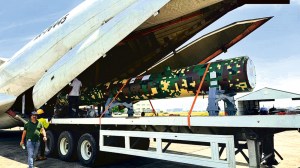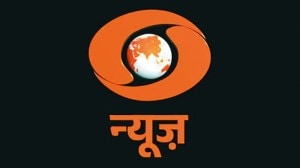- India
- International
Samagra Shiksha switch to online classes for secondary, higher secondary students
The small conference room right next to the state project director's office at the SS headquarters has been transformed into a makeshift studio where these live classes are shot.
 Vardaben Raval records her lecture at the Command and Control Centre in Gandhinagar. (Express Photo)
Vardaben Raval records her lecture at the Command and Control Centre in Gandhinagar. (Express Photo)
“Please like, share and feel free to give your feedback,” says Mihir Kothari, 30, as he closes his 45-minute live session on polynomials. As soon as the video camera mounted on a tripod in a small makeshift studio at the Samagra Shiksha (formerly known as Sarva Shiksha Abhiyan) headquarters in Gandhinagar stopped rolling, the on-screen lively Mathematics teacher at the SP Swami GJ Vidyalaya in Nakhatrana taluka of Kutch district is back to his reserved, shy self.
Kothari is one of the 30 teachers who have been shortlisted from over 60,000 secondary and higher secondary government, grant-in-aid and private school teachers from across Gujarat under the Samagra Shiksha’s (SS) online teaching initiative launched for Classes 9 to 12 for Mathematics and Science subjects on July 21.
After screening, he went through an audition where he had to enact to teach a live class, followed by a week-long training.
In addition to the state education department’s offline learning modes, including television channels, Bhaskaracharya Institute of Space Applications and Geoinformatics (BISAG) channels, WhatsApp groups, launched during the lockdown in the wake of Covid-19 outbreak in March, Samagra Shiksha (SS) is expanding to live classes through four platforms – YouTube, Microsoft Teams, Jio TV and Facebook. The Gujarat education department not only plans to continue them after the pandemic to make up for the shortage of teachers in the higher secondary sections, but also monetise them in future.
The small conference room right next to the state project director’s office at the SS headquarters has been transformed into a makeshift studio where these live classes are shot. To understand how live classes function, the SS team also asked one of the popular private tuition classes running in Ahmedabad to give a live demo.

“Once we had decided to go for these live classes for secondary and higher secondary classes, where there is already a shortage of teachers, we did not want to get stuck under financial constraints. So we had entirely used the existing infrastructure, not spending on anything except the two hired video cameras that we are using at the moment. We are planning to buy our own soon,” Samagra Shiksha state project director P Bharathi told The Indian Express.
The interactive screen already available for presentations in the conference room is now equipped with a free livestreaming software. The Management Information System (MIS) team has doubled up as technical support, while the quality enhancement (QE) team is working on content and teachers selection process.
While delivering his Mathematics lecture, Kothari keeps checking his mobile phone to quickly read out students’ names who have responded to his questions and lauds those with correct answers. Kothari is the only private school teacher, of the 30 shortlisted, 25 being from grant-in-aid schools and 4 from government schools.
“Keeping students engaged in a live class that too in Maths is a challenge which I try to overcome with a two-way interaction process,” he says as the next teacher-Vinay S Patel (53), a science teacher from a grant in aid school in Vadadla village of Petlad taluka in Anand district, checks his notes on his laptop for the last time as he is asked by the technical team in the studio to take over.
“For a normal class, at times we can afford to go unprepared but for even one such class, it takes me two to three hours to prepare one lecture. Still, this is a better mode of teaching as in a regular class we cannot use technology but here we can show them live experiments and digital content which is not possible through textbooks,” says Patel.
Two recording studios, one each at the SS headquarters and the Command and Control Centre (CCC) of the education department, have been turned into live classrooms for classes 9 and 10. Two more were added on July 30.
These lectures are also available on the four platforms and a dedicated YouTube channel called ‘Gujarati Class’. This has recorded over 1.2 lakh subscribers and nearly 50 lakh views. The audience for these live classes is nearly 28 lakh government and grant-in-aid secondary and higher secondary school students, while another 10 lakh from private schools who can also access without any restriction.
“With these numbers, I am told that we are eligible under YouTube’s revenue generation model. We are thinking of generating revenue out of these as this will not only cover our costs but also help in improving these live sessions,” says Bharathi, adding that even after Covid-19 this learning material on the channels would make up for the shortage of secondary and higher secondary teachers.
According to Anil Upadhyay, Quality Enhancement (QE) team member at SS, teachers were first shortlisted from the 275 best ones shared by the district education officers. After screening their teaching methodology they were, through Google forms, asked if they would commute to Gandhinagar, if they were comfortable going live, and so on.
Few refused to commute, some were found wanting in “delivery and technological skills” and that’s when the search expanded to faraway districts like Kutch, says Prakash Trivedi, another QE team member.
The existing team of 30 teachers are from Kutch, Patan, Mahisagar, Aravalli, Anand, Surendranagar, Ahmedabad and Gandhinagar who get an honorarium of Rs 500 and travel and dearness allowance.
Vardaben Raval, 30, who teaches science in Class 10 at the Government Model School, Limdi in Surendranagar district, moved her family to Gandhinagar till the time she is here for the sessions. She says how content cleared of copyrights only can be used for her classes.
Another teacher Vimal Suthar (50) from a grant-in-aid school in Balasinor in Mahisagar district stays with relatives in Gandhinagar.
A tech support team member says that the live streaming viewership has increased from 700-800 to 2,500 in two weeks.
Apr 20: Latest News
- 01
- 02
- 03
- 04
- 05






































